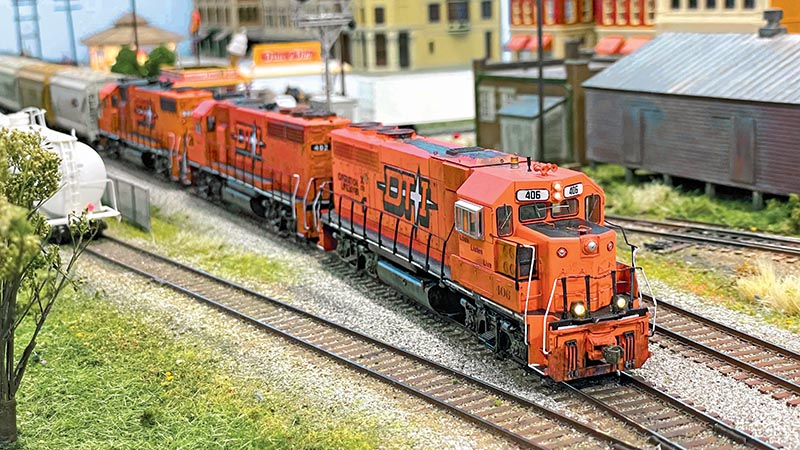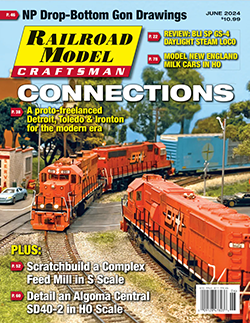 by Shaun Guzman-Thacker/photos by the author
by Shaun Guzman-Thacker/photos by the author
The Detroit, Toledo, & Ironton Railroad is one of those obscure railroads that has a bit of a cult following. A combination of two smaller railroads dating back to the 1890s, the company was reorganized as Detroit, Toledo & Ironton in 1905. Purchased by Henry Ford in 1920, the railroad provided a strategic route between his automobile factory in Dearborn, Mich., and connecting railroads of the Midwest. In 1930, DT&I was sold and became a subsidiary of Pennsylvania Railroad.
After the bankruptcy of Penn Central in 1970, the line was sold to private interests. Grand Trunk Western acquired the line in 1980, and for a brief time, some locomotives were painted in GTW blue and white with DT&I logos. Operations on the southern end were abandoned following a tunnel collapse in 1982. By the end of 1983, DT&I was completely absorbed into GTW, becoming yet another “fallen flag.”
During its heyday, DT&I carried a wide variety of traffic, including steel, lumber, and automotive. The amount of diversity wrapped up in a small line makes it hard not to be a fan. But what if you don’t want to model the 1970s, or earlier? And how do you get around the fact the railroad ceased to exist by 1984? Luckily, we have modeler’s license, and a philosophy known as “proto-freelancing.”
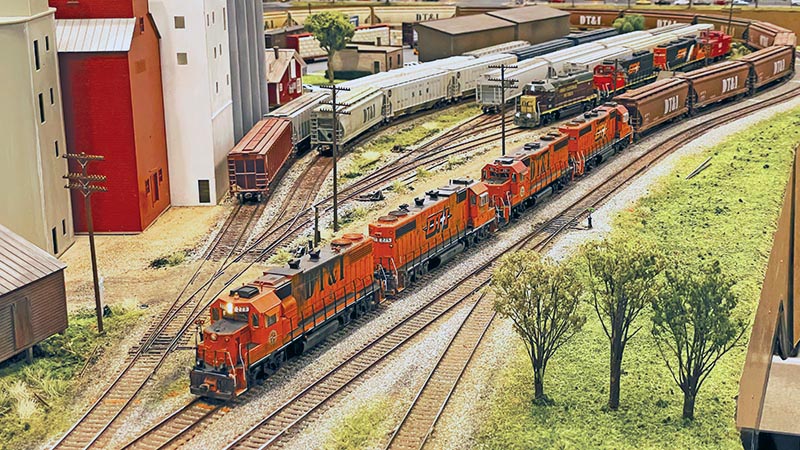
ABOVE: It wouldn’t be a Midwest regional railroad without a grain elevator! The complex shown here is the largest industry on the layout, and can handle up to 24 grain cars at a time.
Proto-freelancing is where you base your model railroad design on a certain prototype railroad’s operations and locations, but allow yourself free rein to explore plausible “what-if” scenarios. Many modelers take their favorite railroad, and either expand its territory or bring it into the present day. Enter the “Modern DT&I.” This is my own take on what the railroad landscape might look like across the Midwest had the DT&I remained intact, independent, and expanded into a successful regional railroad.
Early Years
I first started experimenting with “modern” ideas for the DT&I in 2005. One of my favorite paint schemes has always been the Grand Trunk repaints of the DT&I locomotives with the “starburst” scheme. Only two units were known to have received this, and rumor has it GTW scrapped the idea because the units with the bright DT&I starburst looked better than their own “wet noodle” logo inherited from parent Canadian National. Since GTW was the American arm of CN, subsidiaries Central Vermont and Duluth, Winnipeg, & Pacific were also under its umbrella, with locomotives painted in similar fashion.
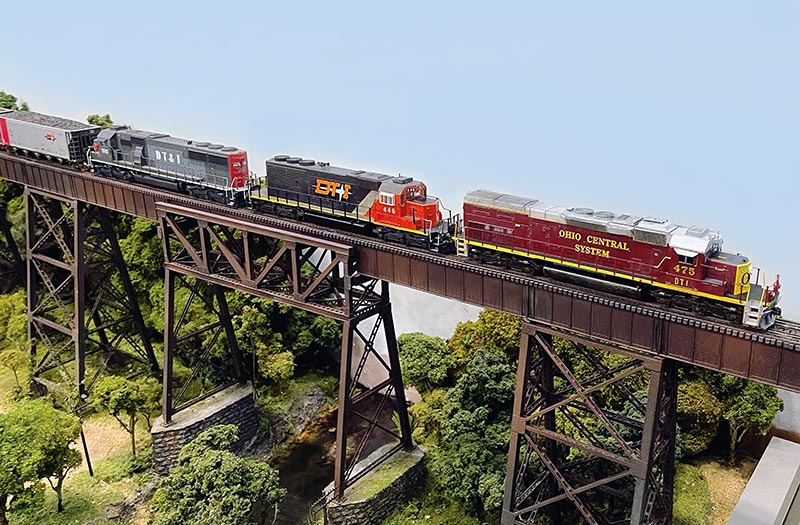
ABOVE: Different eras of growth are represented here. The Ohio Central was merged in 2006. The Canadian National unit represents the DT&I’s former parent company. The ex-Southern Pacific unit is representative of the strong relationship of the two roads responsible for much of the growth the Modern DT&I has experienced.
The thought of a parent company consolidating several smaller and somewhat independent roads intrigued me. My original concept for the Modern DT&I had GTW keeping its subsidiary roads separate, but in similar colors, just as the prototype initially did, but never fully merging them. After parent CN began repainting locomotives, the subsidiary roads followed suit, applying CN black, red, and white colors with the respective railroad logo. This is officially where the modeled version of the Modern DT&I was born. The resulting HO model received a great deal of positive feedback in various online forums, and the CN-owned version of the Modern DT&I took off.
Early in the concept, I struggled to find the right identity for the railroad. I wanted to expand it, but I didn’t want to operate it as a Class 1. A major allure of the DT&I is how it was the “hometown railroad” for the communities it passed through. There are many interesting stories of the company offering specialized services and connections from barely-there villages to the rest of the world. I wanted to maintain that look and feel, as well as project what those communities might look like with a supportive transportation partner in the area.
One of my primary goals was to reinstate the old DT&I slogan, “We Have the Connections.” I set out to find some other proto-freelance partners to work with, however, because I did not have a clear vision of what I wanted the railroad to be yet. I found myself competing for a voice among other Class 1 modelers. To be fair, most of the prototype regional railroads I base the Modern DT&I on were still very new at the time, and it was unclear what would happen to prototype traffic.
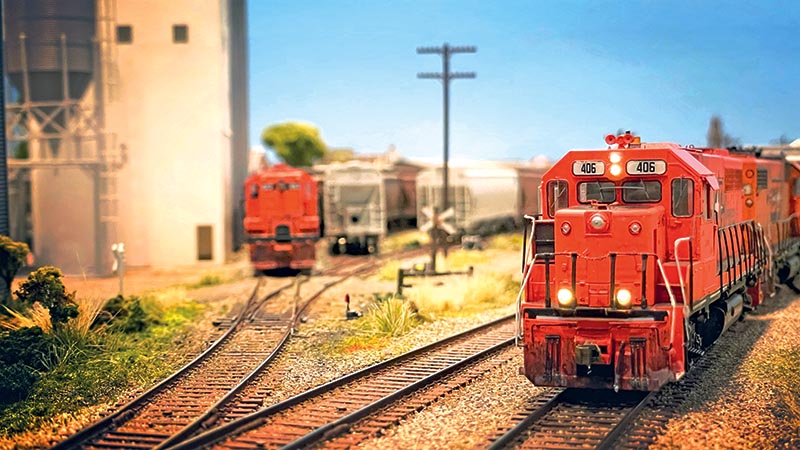
ABOVE: This layout is built for photography! Most details are metal, so are not easily broken when reaching into the layout to take a photo. The scenery is also reinforced with multiple layers of glue. You can walk on it without damaging it (but please don’t)!
The first Modern DT&I layout allowed me to refine my modeling skills. Although I had built several smaller layouts before this, they were always temporary in one way or another. This layout came together fantastically and provided several years of enjoyment. It also became somewhat popular on YouTube and other social media, which in turn helped the concept evolve and grow.
The Modern DT&I
Fast-forward several more years to 2018, and the opportunity to build a more permanent layout became a reality. This began the Modern DT&I layout you see today. Before I even started on a track plan, I spent several nights and weekends writing out the concept for the railroad. This hobby has a wealth of resources, and I’ve been lucky to make some great connections with fellow modelers and railroaders who offered their real-world expertise. This allowed me to develop a concept that potential interchange partners could better understand where they fit and how we could work well together. This effectively re-launched the Modern DT&I world. I moved the layout era forward in time by about 20 years. This made the Modern DT&I even more modern, with CN selling it off to private ownership and a return to the orange paint of the 1970s…


